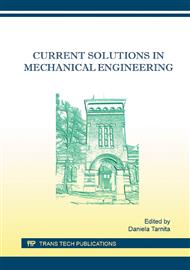[1]
R. Huiskes, E.Y. Chao, A survey of finite element analysis in orthopedic biomechanics: the first decade, J. Biomechanics, 16(6), (1983) 385-409.
DOI: 10.1016/0021-9290(83)90072-6
Google Scholar
[2]
R. Huiskes, R. Boeklagen, Mathematical Shape Optimization of Hip Prosthesis Design, J. Biomechanics, 22(8/9), (1989) 793-804.
DOI: 10.1016/0021-9290(89)90063-8
Google Scholar
[3]
R. K Korhonen The effect of geometry and abduction angle on the stresses in cemented UHMWPE acetabular cups – finite element simulations and experimental tests, BioMedical Eng. OnLine (2005), 4-32.
DOI: 10.1186/1475-925x-4-32
Google Scholar
[4]
A. Stops, R. Wilcox, Z., Jin, Computational modelling of the natural hip: a review of finite element and multibody simulations, Computer Methods in Biomechanics and Biomedical Engineering, 15(9), (2012) 963–979.
DOI: 10.1080/10255842.2011.567983
Google Scholar
[5]
A.B. Lennon, J.R. Britton, et al, Predicting Revision Risk for Aseptic Loosening of Femoral Components in Total Hip Arthroplasty in Individual Patients - A Finite Element Study, Journal of Orthopaedic Research, Orthopaedic Research Society, Wiley Periodicals, (2007).
DOI: 10.1002/jor.20346
Google Scholar
[6]
G. Buciu, D. Grecu, et al., Two New Designs of Tibia Nails Which Eliminate Interlocking Screws and Finite Element Analysis, Current Health Sciences Journal, 39(4), (2013) 39-41.
Google Scholar
[7]
M. Heller et al., Influence of prosthesis design and implantation technique on implant stresses after cementless revision THR, Journal of Orthopaedic Surgery and Research (2011), 6-20.
DOI: 10.1186/1749-799x-6-20
Google Scholar
[8]
M.J. Schmitz, R. Howald, M. Froehlich, E. Siggelkow, D. Hertig, S.E. Clift, Press-fit and the Alloclassic stem: FE predictions vs. clinical evidence. Journal of Biomechanics 39(S1), S412 (2006).
DOI: 10.1016/s0021-9290(06)84675-0
Google Scholar
[9]
A. Herrera, J. Panisello, Comparison between DEXA and finite element studies in the long-term bone remodeling of an anatomical femoral stem. Journal of Biomechanical Engineering 131(4) (2009) (Art. 041013/1-11).
DOI: 10.1115/1.3072888
Google Scholar
[10]
I.G. Jang, B.M. Kwak, Design space optimization using design space adjustment and refinement. Structural Multidisciplinary Optimization 35, (2008) 41–54.
DOI: 10.1007/s00158-007-0112-8
Google Scholar
[11]
R. Huiskes, Failed Innovation in total hip replacement; Diagnosis and proposals for a cure, Acta. Orthop. Scand., 64(6) (1993) 699-716.
DOI: 10.3109/17453679308994602
Google Scholar
[12]
Information on http: /www. mscsoftware. com.
Google Scholar
[13]
D. Calin, D. Tarnita, et al, Virtual Model and Simulation of the Normal and Affected Human Hip Joint, Applied Mechanics and Materials (to be published).
DOI: 10.4028/www.scientific.net/amm.823.167
Google Scholar


